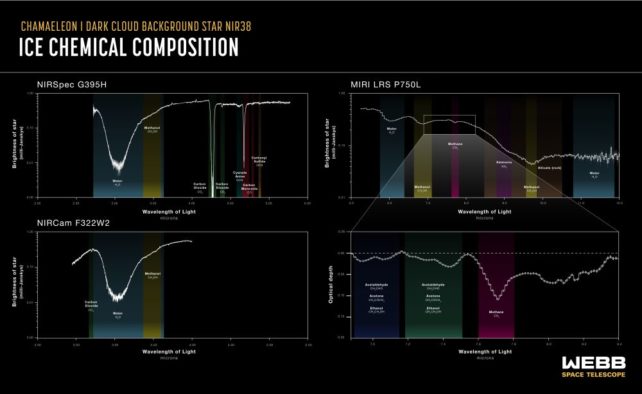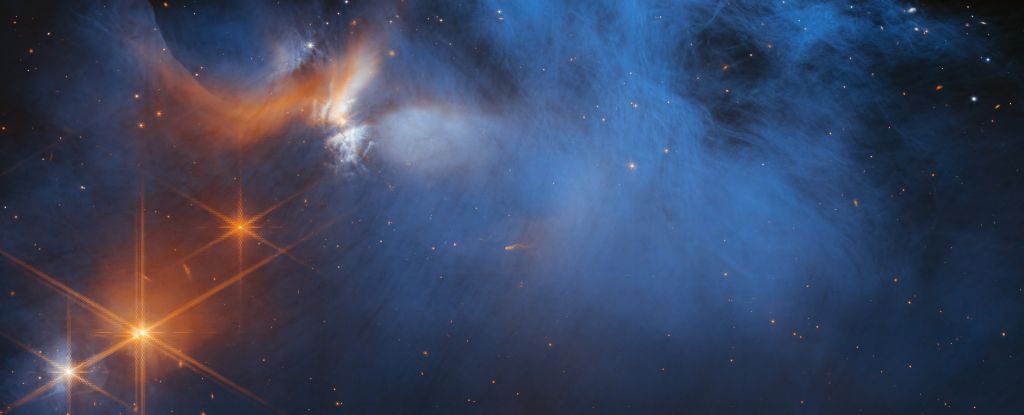JWST’s unprecedented ability to peer into the veiled hearts of distant clouds has revealed the elements of biochemistry in the coldest, darkest place we have seen them yet.
In a molecular cloud called Chamaeleon I, located over 500 light-years from Earth, data from the telescope have revealed the presence of frozen carbon, hydrogen, oxygen, nitrogen and sulfur — elements critical to the formation of atmospheres and molecules like amino from Critical are acids, collectively known as CHONS.
“These elements are important components of prebiotic molecules such as simple amino acids – and thus, so to speak, components of life,” says astronomer Maria Drozdovskaya from the University of Bern in Germany.
In addition, an international team of researchers led by astronomer Melissa McClure of Leiden University in the Netherlands have also identified frozen forms of more complex molecules such as water, methane, ammonia, carbonyl sulfide and the organic molecule methanol.
Stars and their planets are born in cold, dense clumps in molecular clouds. Scientists believe that CHONS and other molecules were present in the molecular cloud that brought forth the sun, some of which were later brought to earth via an icy comet asteroid Effects.
Though the elements and molecules discovered in Chamaeleon I are just floating around, they may one day be caught up in planet formation and provide the ingredients needed for life to emerge on new baby planets.
“Our identification of complex organic molecules such as methanol and possibly ethanol also suggests that the many star and planetary systems evolving in this particular cloud will inherit molecules at a fairly advanced chemical state,” explains astronomer Will Rocha the Leiden Observatory.
“This could mean that the presence of prebiotic molecules in planetary systems is a common result of star formation rather than a unique feature of our own solar system.”
Cold and dense, Chamaeleon I is a dark conglomerate of dust and ice that represents one of the closest active star-forming regions to Earth. A count of its composition can therefore tell us something about the ingredients that go into the formation of stars and planets, and help to understand how these ingredients are incorporated into emerging worlds.
With its powerful infrared detection capabilities, JWST is able to see through dense dust with more clarity and detail than any telescope before it. That’s because infrared wavelengths of light don’t scatter dust particles the way shorter wavelengths do, meaning instruments like JWST can effectively see through dust better than optical instruments like Hubble.

To determine the chemical composition of the dust in Chamaeleon I, scientists rely on absorption signatures. Starlight traveling through the cloud can be absorbed by elements and molecules within. Different chemicals absorb different wavelengths. When a spectrum of the exiting light is collected, these absorbed wavelengths are darker. Scientists can then analyze these absorption lines to determine which elements are present.
JWST has delved deeper into Chamaeleon I to get a count of its composition than we’ve ever seen before. It found silicate dust grains, the aforementioned CHONS and other molecules, and ice colder than any previously measured in space, at about -263 degrees Celsius (-441 degrees Fahrenheit).
And they found that the amount of CHONS for the cloud’s density was less than expected, including only about 1 percent of the expected sulfur. This suggests that the rest of the materials could be trapped in places that can’t be measured — for example, in rocks and other minerals.
It’s hard to tell at this point without more information, so the team wants to get more information. They hope to get more observations that will help them map the evolution of these ices, from coating the dusty grains of a molecular cloud to their incorporation into comets and maybe even seeding planets.
“This is just the first in a series of spectral snapshots we will receive to see how the ice evolves from its initial synthesis to the comet-forming regions of protoplanetary disks.” says McClure.
“This will tell us which ice mix – and therefore which elements – can ultimately be delivered to the surfaces of terrestrial exoplanets or absorbed into the atmospheres of giant gas or ice planets.”
The research was published in natural astronomy.
And you can download background size versions JWST’s image of Chamaeleon I here.





